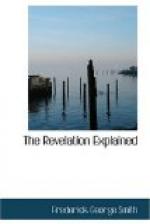The throne of the omnipotent One was surrounded by a beautiful rainbow of emerald clearness, and was probably a perfect one, or a complete circle, such as ours would be could it come wholly into our sight. The rainbow on the cloud, to Noah and his descendants, constitutes the sure pledge of God’s covenant promise not to destroy the earth with another deluge; so, also, the bow surrounding the throne is a symbol of God’s covenant favor with his people eternally.
There were “lightnings and thunderings and voices” proceeding from the throne—the same outward manifestations as heralded the Godhead when he came down on Sinai to declare his holy law. The “seven lamps of fire burning before the throne” are said to signify the seven spirits of God. These are not lamp-stands or candle-sticks, such as the ones in the midst of which the Son of God walked on earth, but seven lights or flames of fire, representing the operation of the Holy Spirit upon the hearts of men and women. Surrounding the throne also was “a sea of glass like unto crystal.” In the Greek it stands in a little different form—“And before the throne as it were a sea of glass.” Describing the same object in chapter 15:2, the Revelator says, “I saw as it were a sea of glass.” It was a broad expanse spread out before the throne with a glassy or transparent appearance like crystal. Its signification will be made clear hereafter.
In addition to this description of the throne and Deity, our attention is directed to certain objects before and surrounding the throne. Four beasts and four and twenty elders are brought to view. The word beasts is a very unfortunate translation, being necessarily associated in our minds with the brute creation. It is not the word therion, which in thirty-five instances in the Apocalypse is translated beast, denoting an animal of wild disposition, but the word zoon, which signifies “a living creature,” and is thus rendered by many of the translators of the New Testament. Their being full of eyes signifies sleepless vigilance and superior intelligence and discernment. The chief description given of the first living creature is that it was “like a lion.” It is stated, not that the creature was a lion, but that it was “like a lion.” It possessed some peculiar quality characteristic of the lion; namely, strength and courage. The second living creature, “like a calf,” or, more properly, the ox, is symbolic of sacrifice or of patient labor. The third, with “a face as a man,” denotes reason and intelligence. While the fourth, “like a flying eagle,” is an emblem of swiftness and far-sighted vision.




